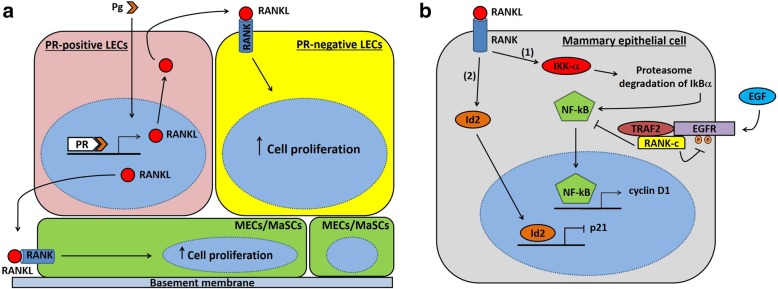Fig. 1.
Schematic diagram showing PR/RANKL pathway and downstream RANK-mediated signaling in mammary epithelial cells. a Natural or synthetic progesterone binds to its receptor in PR-positive breast luminal cell, leading to an increase in RANKL protein levels mainly through stabilization of its mRNA. Then, RANKL binds to its cognate receptor RANK expressed on the surface of the neighboring PR-negative breast luminal cell, activating downstream signaling pathways that promote cell proliferation. Basal cells (MECs and MaSCs, drawn in green at the bottom of the figure) constitutively express RANK on their surface, but they lack PR. RANKL produced by PR-positive breast luminal cells further up-regulates RANK expression on MECs and MaSCs surface, and activates RANK-downstream signaling pathways promoting cell proliferation, expansion and survival. b RANK-IKK-α-NF-kB-cyclin D1 pathway (1), and RANK-Id2-p21 pathway (2) represent the two main signaling pathways activated by RANK in mammary epithelial cells. IKK-α catalyzes phosphorylation, ubiquitination and proteasome degradation of IkBα, leading to its dissociation from NF-kB, which then migrates to the nucleus and induces cyclin D1 transcription. On the other hand, Id2 translocates into the nucleus and reduces expression of the cell cycle inhibitor p21. Altogether, these molecular events result in increased proliferation and survival of mammary epithelial cells. RANK-c is a RANK isoform derived from alternative splicing of RANK gene, which has been identified in breast cancer cell lines and breast tumors. It acts as a dominant negative regulator of RANK-dependent NF-kB activation, inhibiting the NF-kB-mediated cell survival effect and correlating with lower cell motility and proliferative index. RANK-c may exert its function through the intracellular interaction with other key molecules, such as TRAF2 and EGFR. Notably, RANK-c has also been shown to act as a negative regulator of EGFR signaling, inhibiting EGFR phosphorylation after EGF ligand stimulation. Abbreviations: EGF, Epidermal growth factor; EGFR, Epidermal growth factor receptor; Id2, inhibitor of DNA binding protein 2; IkBα, inhibitor of kappa Bα; IKK-α, inhibitor-kB kinase-α; LECs, luminal epithelial cells; MaSCs, mammary stem cells; MECs, myoepithelial cells; NF-kB, nuclear factor-kB; Pg, natural or synthetic progesterone; PR, progesterone receptor; RANK, receptor activator of NF-kB; RANKL, receptor activator of NF-kB-ligand; TRAF2, TNF receptor-associated factor-2

